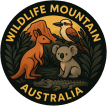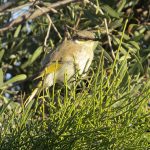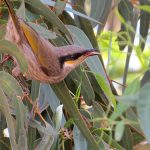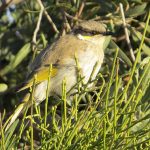SINGING HONEYEATER
Singing Honeyeater
First light spills over a line of coastal dunes. The air tastes faintly of salt; banksias release a warm, honeyed scent as the sun loosens their cones. From a heath-top shrub, a clear, melodious phrase cuts through the hush—bright, ringing, and surprisingly varied. A small bird with an olive-grey back and a neat black eye-mask leaps to another branch, tail flicking. It pauses, throat quivering, then pours out another cascade of notes. It is the Singing Honeyeater, living up to its name.
Who they are
- Scientific name:
Gavicalis virescens(familyMeliphagidae) - Size: about 17–21 cm, slender with a slightly downcurved bill
- Status: Common and widespread; IUCN Least Concern
The Singing Honeyeater is one of Australia’s most adaptable honeyeaters, thriving from wave-washed coasts to red-dust inland shrublands, and even well-planted gardens.
How to recognise one
- Face: Distinct black mask through the eye, neatly edged with a soft yellow line
- Plumage: Olive-grey to brownish upperparts; paler underparts with a gentle wash of grey or buff
- Bill: Slim, slightly curved—perfect for sipping nectar and picking insects
- Sexes: Male and female look alike; juveniles are duller with a less-defined mask
If you’re unsure, look for the bold mask and the clean, understated colours—no big white face plumes, no stark stripes—just tidy, practical elegance.
Voice: the reason for the name
- Song: Clear, ringing, and varied; a lively mix of phrases that can carry across open country
- Calls: Sharp scolds and chatters when annoyed, softer contact notes while foraging
- Fun note: Their song varies by region, giving local “dialects” a distinctive flavour
Listen in early morning or late afternoon when birds defend feeding sites or keep in contact across low, scrubby landscapes.
Range and habitat
- Where: Widespread across much of Australia, especially arid and semi‑arid zones, coastal heath and scrub, mallee, chenopod shrublands, open woodlands, and towns with native plantings
- Absent or scarce: Much of the wetter far south‑east and Tasmania
- Movement: Largely resident but locally nomadic, shifting with flowering cycles and rainfall
Diet and daily life
- Eats: Nectar (banksias, eucalypts, grevilleas, eremophilas), insects and spiders, and occasional fruit
- Foraging style: Probes flowers, gleans from foliage, and snaps at flying insects mid‑air
- Temperament: Assertive around good nectar sources; will chase other birds from a favoured shrub
- Ecological role: A busy pollinator and natural insect control, helping native plants set seed and keeping small invertebrate numbers in check
Stand quietly by a flowering Eremophila or Grevillea and you may see pollen dusting the bird’s face—evidence of work done.
Breeding
- Season: Mostly late winter to summer in the south, but after rain in arid regions
- Nest: A small, neat cup of grasses, rootlets and spider silk, usually low in a shrub
- Clutch: Commonly 2–3 speckled eggs
- Care: Both adults feed the chicks; they are vigilant and will mob larger birds that stray too close
Similar species and how to tell them apart
- White‑plumed Honeyeater: Obvious white moustache plume and greener tones; lacks the solid black eye‑mask
- New Holland Honeyeater: Bold black-and-white patterning with bright yellow in the wings and tail—much more contrasting
- Spiny‑cheeked Honeyeater: Larger, with spiky cheek feathers and a pinkish tone to the face
The Singing Honeyeater is the “subtle mask and olive tones” bird.
Where to see one
- Coastal heath and dunes in Western Australia and South Australia
- Inland woodlands and shrublands across much of the interior
- Town parks and gardens planted with native flowering shrubs
Patience helps: stand downwind, listen for the bright phrases, and scan shrubs at shoulder height.
Conservation and how to help
- Status: Secure overall, but local pressures include habitat clearing, reduction of native understorey, and predation by cats
- What you can do:
- Plant native nectar species like
Banksia,Grevillea,Eremophila, and floweringEucalypt - Keep cats indoors or supervised
- Provide fresh water in a shallow, elevated dish with nearby cover
- Retain dense shrubs for nesting and shelter
- Plant native nectar species like
Small gardens collectively become stepping stones, linking habitat across suburbs and towns.
Quick facts at a glance
| Feature | Detail |
|---|---|
| Scientific name | Gavicalis virescens |
| Family | Meliphagidae (honeyeaters) |
| Size | 17–21 cm |
| Key ID | Black eye‑mask edged yellow; olive‑grey tones |
| Voice | Clear, varied, melodic phrases; sharp scolds |
| Diet | Nectar, insects, spiders, some fruit |
| Nest | Small cup in shrubs; 2–3 eggs |
| Range | Much of Australia, especially drier regions |
| Conservation | Least Concern |
The Singing Honeyeater’s voice is a bright thread stitching together sea‑spray coasts, quiet mallee, and sun‑lit gardens. Its music is not just decoration; it signals a healthy web of flowers, insects and sheltering shrubs. When we plant and protect those places, the song carries on—clear, welcoming, and distinctly Australian.








